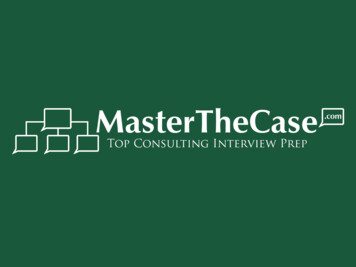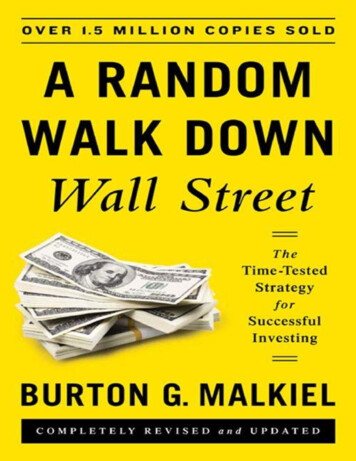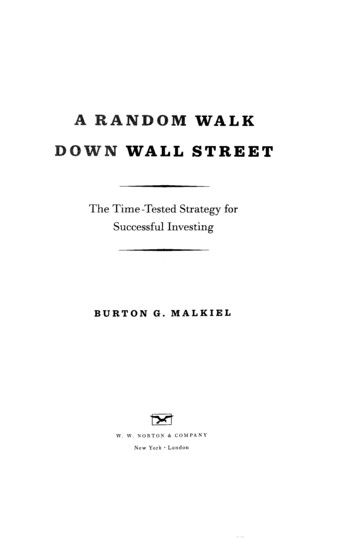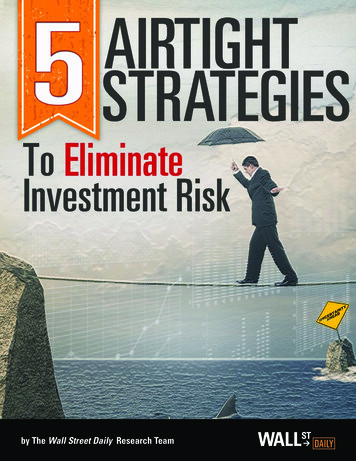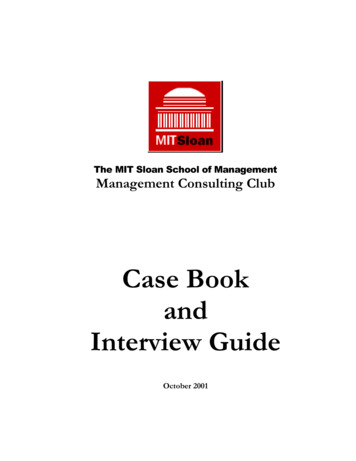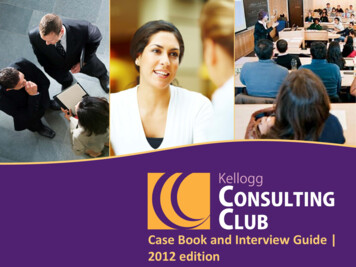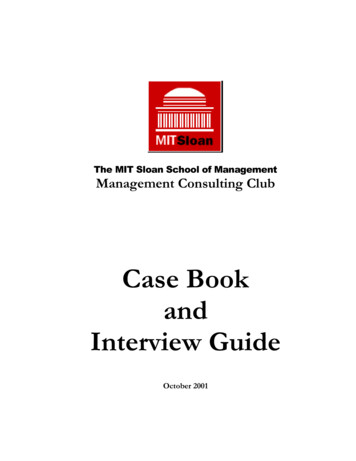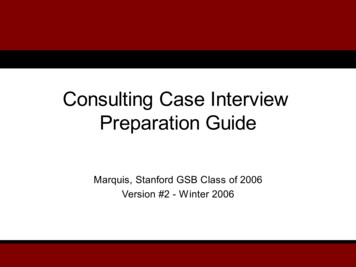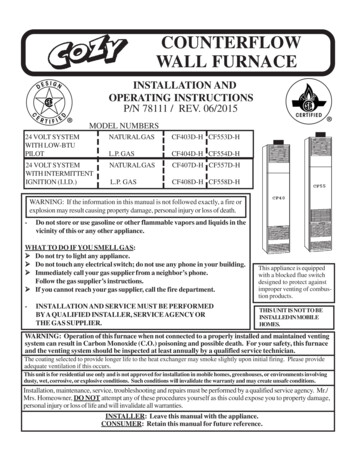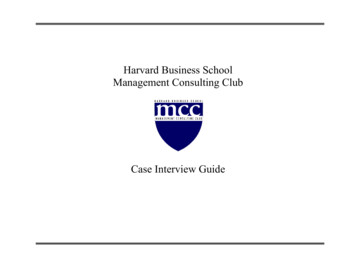
Transcription
Harvard Business SchoolManagement Consulting ClubCase Interview Guide
Harvard Business SchoolManagement Consulting ClubCase Interview GuideCases contributed by Management Consulting Club and consulting companies.Note: Case guide is strictly for the use of current HBS Management Consulting Club members.No part of this document may be reproduced or transmitted in any form or by any means—electronic, mechanical,photocopying, recording, or otherwise—without the permission of HBS Management Consulting Club.
TABLE OF CONTENTSINTRODUCTION: OVERVIEW OF THE CASE. 1OVERVIEW OF CASE FRAMEWORKS. 3PORTER’S FIVE FORCES. 4MARKETING/STRATEGY CONCEPTS REVIEW – OVERVIEW. 6MARKETING/STRATEGY CONCEPTS REVIEW – THE 4 CS. 7MARKETING/STRATEGY CONCEPTS REVIEW – THE 4 PS . 24MARKETING/STRATEGY CONCEPTS REVIEW – CONTRIBUTION ANALYSIS . 28MARKETING/STRATEGY CONCEPTS REVIEW – MARKET SIZING AND SEGMENTATION. 29OPERATIONS CONCEPTS REVIEW. 30PROFITABILITY FRAMEWORK. 31HELPFUL HINTS . 32PRACTICE CASES. 33PRACTICE CASE 1 (RETAILER) . 34PRACTICE CASE 2 (BUTCHER SHOP) . 36PRACTICE CASE 3 (JUICE PRODUCER). 39PRACTICE CASE 4 (CHEMICAL MANUFACTURER) . 41PRACTICE CASE 5 (VIETIRE) . 43PRACTICE CASE 6 (WORLD VIEW). 45PRACTICE CASE 7 (LE SEINE) . 47PRACTICE CASE 8 (BEER BREW). 49PRACTICE CASE 9 (WHEELER DEALER) . 51PRACTICE CASE 10 (TRAVEL AGENCY) . 53PRACTICE CASE 11 (HOSPITAL) . 55PRACTICE CASE 12 (E-GROCERY) . 58
PRACTICE CASE 13 (FORMULA PRODUCER). 61PRACTICE CASE 14 (PHARMACEUTICAL COMPANY) . 64PRACTICE CASE 15 (SCOTCH MANUFACTURER) . 70PRACTICE CASE 16 (REGIONAL JET CORPORATION) . 79PRACTICE CASE 17 (BRITISH TIMES) . 87PRACTICE CASE 18 (CHILDREN CLOTHES E-RETAILER) . 91PRACTICE CASE 19 (CONSUMER PRODUCTS) . 96PRACTICE CASE 20 (THE VIDEO STORE). 98PRACTICE CASE 21 (THE ENGLISH CHURCH). 102PRACTICE CASE 22 (HBS AS A BUSINESS). 104PRACTICE CASE 23 (FAST FOOD RESTAURANT) . 106PRACTICE CASE 24 (AUTOMOBILE PRODUCER) . 109
Introduction: Overview of the CaseThe first question that might pop into your mind is why do management consulting firms give cases during their interviews? What isthe point of these cases? Contrary to what some might think, cases are not just another tool used by firms to weed people out of theburgeoning volume of applicants. They are in fact an excellent indicator of how good you will be as a consultant, pure and simple.Almost everyday, consultants face the kinds of problems and questions often presented in these cases. Often times, toughproblem-solving questions are asked face-to-face by their clients, under pressure, with the expectations of receiving some answers.The case is usually a business situation where the client is facing a difficult problem with the company/product/competitors or isthinking of a new opportunity to explore and asks you to help address some of the issues. The case can be a problem, a situation, ariddle, an example of a real client situation, a contrived scenario, or a game—all rapped up into one. It is an exercise for the firms totest your analytical thinking and to examine how well you can handle problem-solving questions. It is also a great opportunity for youto determine whether consulting is actually right for you. If you do not enjoy problem-solving case interviews, the likelihood that youwill enjoy consulting is fairly small.Because it is an exercise in problem solving, the case is not about finding the right or wrong answer, but rather about the method youuse to derive your answer. It is about the questions you raise, the assumptions you make, the issues you identify, the areas ofexploration you prioritize, the frameworks you use, the creativity involved, the logical solution you recommend, and the confidenceand poise you present.HBS Case Interview Guide, Page 1
The case also gives a strong indication of your personality in that type of setting. Aside from the problem-solving skills listed above,the interviewer uses the case to determine whether the firm would feel comfortable putting you in front of a client. Would you be ableto handle a client situation with confidence when presented with a similar situation? Also, the interviewer wants to see if you have funsolving problems. They want to see enthusiasm from you when faced with ambiguity and tough issues. Consultants almost alwayswork in teams and the questions the interviewer is asking him/herself are: "Would I want to staff this person on my team? Would Ihave fun working with him/her?" So make sure you are relaxed and have fun.There are many types of cases that firms use. This guide covers some of the frameworks and concepts that would help you tackle mostcases that come your way. No case ever fits perfectly into a "type", like marketing or strategy. Most of the cases presented cover anumber of concepts that would range from market sizing and operations to economics. This guide provides a review of majorframeworks and concepts that will be very helpful in Cracking the Case.HBS Case Interview Guide, Page 2
Overview of Case FrameworksA complete understanding of the frameworks and concepts covered in this section is critical to conducting a successful case interview.Most "Plans of Attack" in Cracking the Case use at least one framework, often times several, to decipher the problem at hand andrecommend a solution.NOTE: It is also very important for you NOT to directly apply these frameworks, i.e., you should never say during a caseinterview, "I'm going to use the 4Cs framework," or "I'll be applying Porter's Five Forces." This approach indicates nocreative or analytical thought on your part! The more comfortable you become with these frameworks, the more you will startto develop your own and customize them according to the nature of the case.Remember, the interviewer is not looking for you to apply a cookie cutter approach to each case. You are expected to make soundjudgment as to which frameworks are appropriate and what components of those frameworks are most applicable to the problem athand. Frameworks are mere enablers that organize and guide your thinking. They are not the driving force behind the solutions andthey certainly are not the solution themselves. The combination of your own intelligence, creativity, and preparation are the drivingforces!HBS Case Interview Guide, Page 3
Porter’s Five ForcesSource: Michael E. Porter, -Competitive Strategy: Techniques for Analyzing Industries and CompetitorsMichael Porter's Five Forces is probably the most famous framework used in preparing for the case interviews. It has endured as one of the frameworksmost talked about by many in and out of the consulting field. Although the Five Forces is an excellent framework in helping you organize you thoughts,like any other framework we cover in this guide, its analysis is not complete. The Five Forces should be used in conjunction with other frameworks toenable you to fully understand the issues at hand. Further, we only briefly touch on this framework here, but we have included more detailed material ofPorter's work later in this guide.NewEntrantsCompetitive advantage in an industry is dependent on five primary forces: The threat of new entrants The bargaining power of buyers/customers The bargaining power of suppliers The threat of substitute products Rivalry with competitorsThe degree of these threats determines the attractiveness of the market: Intense competition allows minimal profit margins Mild competition allows wider profit marginsBuyersCompetitiveRivalryThe goal is to assess whether a company should enter/exit the industry orfind a position in the industry where it can best defend itself against theseforces or can influence them in its favor.SubstituteProductsHBS Case Interview Guide, Page 4Suppliers
Porter’s Five ForcesSource: Michael E. Porter, Competitive Strategy: Techniques for Analyzing Industries and CompetitorsBarriers to Entry:There are a number of factors that determine the degree of difficultyin entering an industry: Economies of scale Product differentiation Capital requirements vs. switching costs Access to distribution channels Cost advantages independent of scale Proprietary product technology Favorable access to raw materials Favorable location Government subsidies Learning curve Government policyRelationship with Buyers:A buyer group is powerful if: It is concentrated or purchases large volumes relative toseller's sales The products it purchases front the industry are standard orundifferentiated It faces few switching costs Buyers pose a credible threat of backward integration The industry's product is unimportant to the quality of thebuyer's products or services The buyer has full informationRelationship with Suppliers:A supplier group is powerful if: It is not obliged to contend with other substitute products forsales in the industry The industry is not an important customer of the suppliergroup The supplier group is an important input to the buyer'sbusiness The supplier group's products are differentiated or it has builtup switching costs The supplier group poses a credible threat of forwardintegrationS
Note: Case guide is strictly for the use of current HBS Management Consulting Club members. No part of this document may be reproduced or transmitted in any form or by any means—electronic, mechanical, photocopying, recording, or otherwise—without the permission of HBS Management Consulting Club.
